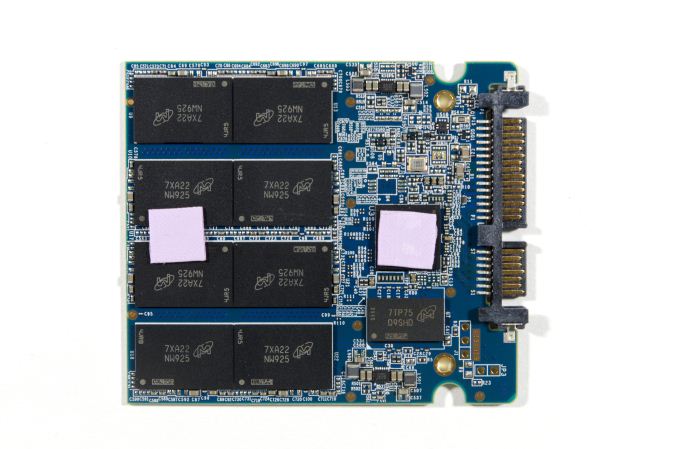The Crucial MX500 500GB SSD Review: A Second Look
by Billy Tallis on February 2, 2018 9:30 AM ESTConclusion
This second look at the Crucial MX500 reinforces our opinion of it as a solid performer, but it definitely isn't the fastest TLC SSD around. It is more common to find the MX500 placing second or third in its class on the performance tests, which isn't a problem if the price is right.
The 500GB MX500 is clearly slower than the 1TB model, and at first glance its performance relative to the competition is not as impressive as the results from the 1TB model. The 500GB capacity class is starting to become the default choice over smaller sizes, but it is no longer big enough to offer full performance even on drives that are limited by the SATA interface. On the other hand, the per-die capacity of the MX500's 64-layer 3D TLC is actually lower than that of the 32L 3D TLC used by the MX300, so the 250GB model shouldn't be as handicapped as the smallest MX300 was.
Since our first look at the Crucial MX500, the Samsung 860 PRO has raised the bar again for SATA SSDs. However, it exists in a price bracket that has been taken over by NVMe SSDs, so it isn't really serious competition for mainstream SATA drives. It is the TLC-based 860 EVO that will really matter. Samsung has clearly refined both their controller and their NAND, and we expect the 860 EVO to improve over the 850 EVO in both performance and power consumption.
When the dust settles on this round of product launches, Crucial will probably once again be in the position of offering a slower but cheaper option than Samsung's mainstream SATA drive. But this time around, the performance gap will be much smaller, and the MX500 comes with far fewer caveats than the MX300. The MX500 doesn't have serious performance problems when full like the MX300 and many other entry-level SSDs. The warranty and write endurance ratings are decent, and the MX series still matches Samsung's SSDs for features like drive encryption.
| SATA SSD Price Comparison | ||||
| 240-275GB | 480-525GB | 960-1050GB | 2TB | |
| Crucial MX500 | $79.99 (32¢/GB) | $134.95 (27¢/GB) | $259.99 (26¢/GB) | $499.99 (25¢/GB) |
| Crucial BX300 | $87.99 (37¢/GB) | $144.99 (30¢/GB) | ||
| Crucial MX300 | $92.99 (34¢/GB) | $147.45 (28¢/GB) | $274.99 (26¢/GB) | $546.23 (27¢/GB) |
| Samsung 850 EVO | $99.99 (40¢/GB) | $149.99 (30¢/GB) | $299.99 (30¢/GB) | $696.00 (35¢/GB) |
| Samsung 860 EVO | $94.99 (38¢/GB) | $169.99 (34¢/GB) | $329.99 (33¢/GB) | $649.99 (32¢/GB) |
| SanDisk Ultra 3D | $79.99 (32¢/GB) | $139.99 (28¢/GB) | $249.99 (25¢/GB) | $549.99 (27¢/GB) |
| WD Blue 3D NAND | $79.99 (32¢/GB) | $139.96 (28¢/GB) | $259.99 (26¢/GB) | $529.99 (26¢/GB) |
| Samsung 850 PRO | $155.00 (61¢/GB) | $219.99 (43¢/GB) | $429.99 (42¢/GB) | $888.61 (43¢/GB) |
| Samsung 860 PRO | $139.99 (55¢/GB) | $249.99 (49¢/GB) | $479.99 (47¢/GB) | $949.99 (46¢/GB) |
| ADATA SU800 | $78.50 (31¢/GB) | $139.99 (27¢/GB) | ||
| Toshiba TR200 | $79.99 (33¢/GB) | |||
| Intel 545s | $89.99 (35¢/GB) | $149.99 (29¢/GB) | ||
Crucial and Samsung are both making quick transitions to their new models: the MX300 and the 850 series SSDs are starting to go out of stock and their prices are climbing. The full range of MX500 capacities are now mostly in stock, as are most of the Samsung 860 PROs and EVOs, and they're all still pretty much stuck at MSRP. Even at MSRP, the Crucial MX500 is priced to beat all the other SATA SSDs using 64L 3D NAND, and it more or less matches the older and slower models that are still available.
Other SSD manufacturers don't seem to have fully reacted yet to the Crucial MX500's pricing. The Western Digital WD Blue 3D/SanDisk Ultra 3D is almost as fast as the MX500 and almost as cheap, so it's a good product to keep an eye on, but not the one to buy if you're buying today (except at 1TB, where the Ultra 3D is $10 cheaper).
The Intel 545s uses similar NAND and controller to the MX500 but usually comes out slightly ahead. However, Intel hasn't been pricing the 545s very aggressively and they haven't released 1TB or 2TB capacities. Toshiba's DRAMless TR200 is barely a presence on the market with only the 240GB model in stock and at a price no cheaper than mainstream drives. The many other brands that don't manufacture their own NAND flash are using the 64L 3D NAND they can acquire for PCIe SSDs, so the rest of the competition for the MX500 is last-generation SATA drives.
The MX500 is one of the cheapest SSDs on the market at the moment, and it offers real-world performance very close to the Samsung 850 EVO. This makes it very easy to recommend.
The only caveat to that recommendation is that power efficiency has taken a step backwards with the MX500, while Samsung appears to be setting new records in that department with the 860 series. We expect our upcoming testing of the 860 EVO to show it using less power than the MX500 and probably offering slightly better performance. But at the moment it looks like those probable advantages come at a pretty steep premium.












25 Comments
View All Comments
KarlKastor - Saturday, February 3, 2018 - link
I would like to see a review of old SSDs (Indlinx Barefoot, first Intel SSDs, Sandforce SSDs, crucial c300, Samsung 830 for example) and how they would compete against today's drives. The test parcours is much more detailed and challenging for the drives. Can older drives pass this test reasonable good enough or is an upgrade to a modern ssd an major improvement, besides of capacity.velanapontinha - Saturday, February 3, 2018 - link
^this^peevee - Monday, February 5, 2018 - link
Most decent SLC SATA drives should be fine, but there were terrible examples like Kingston V-series which were not much better than HDDs to begin with.But I'd like to see the tests too.
Dragonstongue - Thursday, June 21, 2018 - link
am using your charts to compare the previous results of the MX200 vs the "new" MX500, and most of the numbers and data have changed to show the MX200 as "better" than it once was, if properly tested, this should not have been shown as such.IMHO, if a drive at a specific time using a specific set of drivers etc had say a data rate of 217.85 (crucial MX200 500gb) why does this review "change" to show this same drive now being 235 (a gain of around 8%)
numbers should not be becoming "magically better" IMO, unless firmware was changed without notification, or tests were not run properly the first time around or something like that?
it is quite hard to do direct comparisons when your data does not agree with itself ^.^
MX500 is supposed to be "a fair bit quicker" in most things than MX200 or MX300 (around 18% for the 500gb models..20 odd % for the 1tb models) something is not agreeing with itself based on your data/numbers/review, this is troublesome to say the least, so I suppose my question in this regard is, how "factual" is the testing methodology being used, such as latency numbers (where the original data of MX200 read higher numbers in ms than this review does making this review appearing as if the mx200 is that much faster than it was previously (less latency)
and the power consumption was also higher previously whereas in this review it uses "less" power, the heck is up with this?
if one screwed up original testing methodology "I understand" but, if one just changes data willy nilly to suit vendors or make the older or newer stuff appear better than it actually is, screw that noise (we already have plenty enough companies/corps that do that crud daily..like Ngreedia, Apple, Intel, MSFT etc)
Just saying, had my eye on the MX500, my MX100 256gb has been working very well for me last 2.5-3 years or something like that (still at 99% life) MX200 500gb still snappy (though not quite as snappy as the MX100 for some reason and I have never had it "loaded" currently is at 92% life and yet is at least a 9 month newer drive, have not copied.deleted anywhere close to as much as it claims I have which is confusing...MX500 is supposed to have that much more endurance, but, if the MX200 seems to "chew" endurance more than it should, that is not a good thing.
I have taken all the steps I can to reduce writing to the drive (unless needed) have trim on since day 1 etc...
Anyways, compare the "original" MX200 data you reviewed dated may 22, 2015, with this review dated february 2, 2018, quite a difference in appearances from how so so the drive appeared (MX200) vs the way it "now" appears (seems like not quite a poor drive, though it never was crud drive)
https://www.anandtech.com/show/9258/crucial-mx200-...
https://www.anandtech.com/show/12263/the-crucial-m...
would say IMO, double check your info (past info) so you are not making silly mistakes if possible (I know no one is perfect by all means, but I highly doubt you keep hundreds of drives on hand so you can test them a year or 2 down the line, most review sites do not, so does this mean pulling numbers out of thin air?)
take care, love your site by all means, lots of good reading ^.^
dpjtpa - Friday, June 14, 2019 - link
This is definitely the option I will be purchasing soon